Reuse of Barley Straw for Handmade Paper Production
Abstract
1. Introduction
2. Materials and Methods
2.1. Raw Material Conditioning
2.2. Proximal Chemical Analysis
2.3. Lignocellulosic Composition of Straw
2.4. Preparation and Evaluation of Handmade Paper Sheets Cooking Process, (Thermal-Alkaline)
2.5. Characterization of Paper Sheets
2.6. Paper Sheet Properties by Instrumental Analysis
3. Results and Discussion
3.1. Proximal Chemical Analysis
3.2. Lignocellulosic Composition of Cereal Straw
3.3. Characterization of the Straws by SEM
Characterization of the Straws by Energy Dispersive X-ray Detector Spectrometer (EDS)
3.4. Physical Properties of the Paper Produced in This Work
| Sample | Basis Weight(g/m2) | Thickness (μm) | Burst Strength (kPa) | Reference |
|---|---|---|---|---|
| A (0–100%) | 93 (4) | 280 (18) | 75.8 (1) | This work |
| B (20–80%) | 87 (3) | 250 (8) | 103.4 (1) | This work |
| C (40–60%) | 82 (2) | 230 (26) | 68.9 (0.5) | This work |
| D (50–50%) | 80 (2) | 220 (5) | 96.5 (1) | This work |
| E (60–40%) | 87 (3) | 220 (5) | 79.9 (1.1) | This work |
| F (80–20%) | 96 (3) | 300 (20) | 96.5 (2) | This work |
| G (100–0%) | 66 (2) | 190 (2) | 89.6 (1) | This work |
| Prunus amydalus | 64 | 110 | 88.3 * | [51] |
| Tamarisk | 64 | 103 | 64.0 * | [51] |
| Palm rachis | 64 | 141 | 84.3 * | [61] |
| Astragalus armatus | 58 | 148 | 148 * | [48] |
| Cynara cardunculus | 61 | 96 | 101 * | [62] |
| Hanji | 80 | 150 | [57] | |
| Agave americana | 82 | 410 | 126 | [34] |
| Saccharum officinarum | 94 | 290 | 165 | [34] |
| Yucca guatemalensis | 76 | 280 | 24.6 | [34] |
| A. altissima kraft | 64 | 43 * | [63] | |
| E. globulos | 65 | 235 * | [63] | |
| Furcraea andina | 64 | 151.91 | [64] | |
| Saccharum officinarum | 100 | 57.5 | [65] | |
| Hibiscus cannabinus | 101 | 370 | [30] | |
| Saccharum officinarumSorghum | 150 | [66] | ||
| Paper | 50–125 | 76–156 | 250–300 | [59,65] |
| Paper | 40–120 | 205–370 | [58] |
Mechanical Properties of the Paper Produced in This Work
| Sample | Burst Index (kPam2/g) | Bulk cm3/g | Reference |
|---|---|---|---|
| A (0–100%) | 0.81 | 3.01 | This work |
| B (20–80%) | 1.18 | 2.87 | This work |
| C (40–60%) | 0.84 | 2.80 | This work |
| D (50–50%) | 1.20 | 2.75 | This work |
| E (60–40%) | 0.91 | 2.52 | This work |
| F (80–20%) | 1.00 | 3.12 | This work |
| G (100–0%) | 1.35 | 2.87 | This work |
| Prunus amydalus | 1.38 | 1.72 | [51] |
| Tamarisk | 1.00 | 1.58 | [51] |
| Palm rachis | 1.32 | 2.21 | [61] |
| A. altissima kraft | 0.68 | 1.99 | [63] |
| E. Globulos | 4.28 | 1.53 | [63] |
| Astragalus armatus | 2.54 | 2.57 | [48] |
| Cynara cardunculus | 1.64 | 1.56 | [62] |
| Musa paradisiaca | 8.2 | [71] | |
| Arundo donax | 0.87 | 1.77 | [69] |
| Agave americana | 1.53 | 5.00 | [34] |
| Typha | 3.10 | [72] | |
| Nicotiana tabacum | 3.98 | [73] | |
| Chamaecytisus proliferus | 0.53 | [13] | |
| Hordeum Vulgare | 2.16 | [41] | |
| Oryza sativa | 1.12 | [10] | |
| Hesperaloe funifera | 4.50 | [70] | |
| Hibiscus cannabinus | 0.25 | 3.62 | [30] |
| Hordeum Vulgare | 4.03 | [28] | |
| Opuntia ficus-indica | 3.20 | [67] | |
| Cicer arietinum | 3.17 | [74] | |
| Musa paradisiaca | 8.20 | [71] | |
| Triticum | 5.80 | [75] | |
| Saccharum officinarum | 2.23 | 2.5 | [66] |
| Sorghum | 2.55 | 2.5 | [66] |
| Oryza sativa | 1.2 | [76] |
3.5. SEM Analysis
3.6. Infrared Analysis
3.7. X-ray Diffraction
4. Conclusions
Author Contributions
Funding
Institutional Review Board Statement
Informed Consent Statement
Data Availability Statement
Acknowledgments
Conflicts of Interest
References
- FAO. FAOSTAT. 2019. Available online: http://www.fao.org/statistics/en/ (accessed on 10 June 2021).
- Rojas-León, A.; Guzmán-Ortíz, F.A.; Bolarín-Miró, A.M.; Otazo-Sánchez, E.M.; Prieto-García, F.; Fuentes-Talavaera, F.J.; Román-Gutiérrez, A.D. Eco-innovation of barley and HDPE wastes: A proposal of sustaibable particleboards. Revista Mexicana Ing. Quím. 2019, 18, 57–58. [Google Scholar] [CrossRef]
- Navaee-Ardeh, S.; Mohammadi-Rovshandeh, J.; Pourjoozi, M. Influence of rice straw cooking conditions in the soda–ethanol–water pulping on the mechanical properties of produced paper sheets. Bioresour. Technol. 2004, 92, 65–69. [Google Scholar] [CrossRef] [PubMed]
- He, J.; Kawasaki, S.; Achal, V. The Utilization of Agricultural Waste as Agro-Cement in Concrete: A Review. Sustainability 2020, 12, 6971. [Google Scholar] [CrossRef]
- Xuan, B.B. Consumer preference for eco-labelled aquaculture products in Vietman. Aquaculture 2021, 532, 736111. [Google Scholar] [CrossRef]
- Zheng, X.; Govindan, K.; Deng, Q.; Feng, L. Effects of design for the environment on firms’ production and remanufacturing strategies. Int. J. Prod. Econ. 2019, 213, 217–228. [Google Scholar] [CrossRef]
- Halada, K. Progress of ecomaterials toward a sutainable society. Curr. Opin. Solid State Mater. Sci. 2003, 7, 209–216. [Google Scholar] [CrossRef]
- Lugo, I.M. Reporte de la Industria del Papel. 2017. Available online: http://mnamexico.com/wp-content/uploads/2017/05/Industria-Papel-4.pdf (accessed on 10 June 2021).
- M’hamdi, A.I.; Kandri, N.I.; Zerouale, A.; Blumberga, D.; Gusca, J. Life cycle assessment of paper production from treated Wood. Energy Procedia 2017, 128, 461–468. [Google Scholar] [CrossRef]
- Kaur, D.; Bhardwaj, N.K.; Lohchab, R.K. Prospects of rice straw as a raw material for paper making. Waste Manag. 2017, 60, 127–139. [Google Scholar] [CrossRef]
- Kulkarni, H.D. Pulp and paper industry raw material scenario-ITC plantation a case study. IPPTA J. 2013, 25, 79–82. [Google Scholar]
- Global Pulp and Paper Board Market Forecast to Grow 1.1%. Pulppapernews, 19 March 2015.
- García, M.M.; López, F.; Alfaro, A.; Ariza, J.; Tapias, R. The use of Tagasaste (Chamaecytisus proliferus) from different origins for biomass and paper production. Bioresour. Technol. 2008, 99, 3451–3457. [Google Scholar] [CrossRef]
- FFI, Finish Forest Industries. Global Paper Consumption is Growing; Finish Forest Industries: Helsinki, Finland, 2013. [Google Scholar]
- Sharma, C.; Kumar, S. Detection of chlorophenolics in effluents from bleaching processes of rice-straw pulp. J. Environ. Monit. 1999, 1, 569–572. [Google Scholar] [CrossRef] [PubMed]
- Ali, M.; Sreekrishnan, T.R. Anaerobic treatment of agricultural residue based pulp and paper mill effluents for AOX and COD reduction. Process Biochem. 2000, 36, 25–29. [Google Scholar] [CrossRef]
- Jiménez, L.; Ramos, E.; Rodrıguez, A.; De la Torre, M.J.; Ferrer, J.L. Optimization of pulping conditions of abaca. An alternative raw material for producing cellulose pulp. Bioresour. Technol. 2005, 96, 977–983. [Google Scholar] [CrossRef] [PubMed]
- Haung, G.; Jafferey, H.; Langrish, T.A.G. Environmentally friendly bagasse pulping with NH4OH-KOH AQ. J. Clean. Prod. 2008, 16, 1287–1293. [Google Scholar] [CrossRef]
- Elhelece, W.A. Rice straw as a Raw Material for Pulp and Paper Production. Encycl. Renew. Sustain. Mater. 2018, 2, 296–304. [Google Scholar] [CrossRef]
- AOAC. Official Methods of Analysis of the Association of Official Analytical Chemists, 15th ed.; Helrich, K., Ed.; AOAC: Rockville, MD, USA, 1990; Volume 2, pp. 777–781, 1095–1096. [Google Scholar]
- TAPPI. Test Methods, Technical Association of the Pulp and Paper Industry (U.S.); TAPPI: Peachtree Corners, GA, USA, 2022; pp. 1–5. [Google Scholar]
- Al Arni, S.; Zilli, M.; Converti, A. Solubilization of lignin components of food concern from sugarcane bagasse by alkaline hydrolysis disolución de componentes lignínicos de interés alimentario a partir de bagazo de caña de azúcar por hidrólisis alcalina. Cyta J. Food 2007, 5, 271–277. [Google Scholar] [CrossRef]
- Bouasker, M.; Belayachi, N.; Hoxha, D.; Al-Mukhtar, M. Physical Characterization of Natural Straw Fibers as Aggregates for Construction Materials Applications. Materials 2014, 7, 3034–3048. [Google Scholar] [CrossRef]
- Canales-Flores, R.A.; Prieto-García, F.; Prieto-Méndez, J.; Acevedo-Sandoval, O.; Otazo-Sánchez, E. Evaluation of three lignocellulose biomass materials (barley husk, corn cobs, agave leaves) as precursors of activated carbon. Rev. Fac. Cienc. 2022, 11, 17–39. [Google Scholar] [CrossRef]
- Toscano Palomar, L.T.; Bautista, A.G.A.; Alpirez, G.M.; Díaz, L.C.; Ramos, R.T.; Uscanga, E.R.; Velázquez, Á.G. Determinación simplificada del contenido de Lignina en paja de trigo por método volumetrico y su caracterización química. Cienc. Tecnol. 2015, 15, 113–124. [Google Scholar] [CrossRef][Green Version]
- Serna-Díaz, M.G.; Mercado-Flores, Y.; Jiménez-González, A.; Anducho-Reyes, M.A.; Medina-Marín, J.; Seck Tuoh-Mora, J.C.; Téllez-Jurado, A. Use of barley straw as a support for the production of conidiospores of Trichoderma harzianum. Biotechnol. Rep. 2020, 26, e00445. [Google Scholar] [CrossRef]
- Contreras-López, E.; Jaimez-Ordaz, J.; Hernández-Madrigal, T.; Añorve-Morga, J.; Beltrán-Hernández, R. Composición química de cebadas cultivadas bajo diferentes condiciones de labranza en tres localidades del estado de Hidalgo, México. Bioagro 2008, 20, 201–208. Available online: https://www.redalyc.org/pdf/857/85714153007.pdf (accessed on 3 December 2018).
- Vargas, F.; González, Z.; Rojas, O.; Garrote, G.; Rodriguez, A. Barley Straw (Hordeum vulgare) as a Supplementary Raw Material for Eucalyptus camaldulensis and Pinus sylvestris Kraft Pulp in the Paper Industry. BioResources 2015, 10, 3682–3693. Available online: https://ojs.cnr.ncsu.edu/index.php/BioRes/article/view/BioRes_10_2_3682_Vargas_Barley_Straw_Paper_Industry (accessed on 10 June 2021). [CrossRef]
- Prado-Martínez, M.; Anzaldo-Hernández, J.; Becerra-Aguilar, B.; Palacios-Juárez, H.; de Jesús Vargas-Radillo, J.; Rentería-Urquiza, M. Caracterización de hojas de mazorca de maíz y de bagazo de caña para la elaboración de una pulpa celulósica mixta. Madera y Bosques 2012, 18, 37–51. Available online: https://www.redalyc.org/articulo.oa?id=61725074004 (accessed on 10 June 2021). [CrossRef][Green Version]
- Smith Udohitinah, J.; Oluwadare, A.O. Pulping properties of kraft pulp of Nigerian-grown kenaf (Hibiscus cannabinus L.). BioResources 2011, 6, 751–761. [Google Scholar] [CrossRef]
- Honorato-Salazar, J.A.; Colotl-Hernández, G.; Apolinar-Hidalgo, F.; Aburto, J. Principales componentes químicos de la madera de Ceiba pentandra, Hevea brasiliensisy Ochroma pyramidale. Madera Bosques 2015, 21, 131–146. Available online: https://www.redalyc.org/articulo.oa?id=61740807010 (accessed on 10 June 2021).
- Singh, S.K.; Matsagar, B.M.; Dhepe, P.L. Determination of Alpha-, Betaa and Gamma- Cellulose in Bagasse and Wheat Straw: Lignin Recovery, Characterization and Depolymerization. Res. Sq. 2021. [Google Scholar] [CrossRef]
- Hájková, K.; Bouček, J.; Procházka, P.; Kalous, P.; Budský, D. Nitrate-Alkaline Pulp from Non-Wood Plants. Materials 2019, 14, 3673. [Google Scholar] [CrossRef]
- García-Berfon, L.; Armijos-Riofrio, C.; Aguilar-Ramírez, S.; López-Cordova, C.; Ramírez-Robles, J.; Calva-Luzon, M.; Pogo-Tacuri, E. Non-woody species study from Loja Province (Ecuador) as potential raw materials for handmade paper manufacture. Ing. Investig. Tecnol. 2021, 22, 2. [Google Scholar]
- Poonam, M.; Kadam, A.; Dutt, D. Delignification of L. leucocephala and C. equisetifolia through kraft pulping and Mitigation of Vessel Picking. BioResources 2019, 14, 3512–3527. Available online: https://ojs.cnr.ncsu.edu/index.php/BioRes/article/view/BioRes_14_2_3512_Maan_Delignification_Leucaena_Casuarina_Kraft_Pulping (accessed on 10 June 2021).
- Presenda-Gerónimo, A.; Bolio-López, G.I.; Veleva, L.; Azamar-Barrios, J.A.; Ramírez-Casillas, R.; Sarracino-Martínez, O.; la Cruz-Burelo, D. Isolation of cellulose from pineapple waste (Ananas comosus L. Merril). Agroproductividad 2020, 13, 77–82. [Google Scholar] [CrossRef]
- Strunk, P.; Lindgren, Å.; Eliasson, B.; Agnemo, R. Chemical changes of cellulose pulps in the processing to viscose dope. Cellul. Chem. Technol. 2012, 46, 559–569. [Google Scholar]
- Ramirez Casillas, R.; Rodríguez, K.F.B.; Cruz-Estrada, R.H.; Dávalos-Olivares, F.; Navarro-Arzate, F.; Satyanarayana, K.G. Isolation and characterization of cellulose nanocrystals created from recycled laser printed paper. BioResources 2018, 13, 7404–7429. [Google Scholar]
- Ramírez-Casillas, R.; López-López, M.; Becerra-Aguilar, B.; Dávalos-Olivares, F.; Satyanarayana, K. Obtaining Dissolving Grade Cellulose from the Huizache (Acacia farnesiana L. Willd.) Plant. BioResources 2019, 14, 3301–3318. Available online: https://ojs.cnr.ncsu.edu/index.php/BioRes/article/view/BioRes_14_2_3301_Ramirez_Casillas_Obtaining_Dissolving_Grade_Cellulose_Huizache (accessed on 10 June 2021).
- Ferrer, A.; Vargas, F.; Jameel, H.; Rojas, O. Influence of Operating Variables and Model to Minimize the Use of Anthraquinone in the Soda-Anthraquinone Pulping of Barley Straw. BioResources 2015, 10, 6442–6456. Available online: https://ojs.cnr.ncsu.edu/index.php/BioRes/article/view/7504 (accessed on 10 June 2021). [CrossRef]
- Juarez, M.; Sanchez, R.; Espinosa, E.; Dominguez-Robles, J.; Bascon-Villegas, I.; Rodriguez, A. Environmentally friendly lignocellulose nanofibres from barley straw. Cellul. Chem. Technol. 2018, 52, 589–595. [Google Scholar]
- Vargas, F.; González, Z.; Sánchez, R.; Jiménez, L.; Rodríguez, A. Cellulosic pulps of cereal straws as raw material for the manufacture of ecological packaging. BioResources 2012, 7, 4161–4170. Available online: https://ojs.cnr.ncsu.edu/index.php/BioRes/article/view/BioRes_07_3_4161_Vargas_Cellulosic_Pulp_Cereal_Straw_Ecological_Package (accessed on 10 June 2021).
- Sridach, W. The Environmentally Benign Pulping Process of Non-Wood Fibers. Suranaree J. Sci. Technol. 2010, 17, 105–123. [Google Scholar]
- Jimenez, L.; Sanchez, I.; Lopez, F. Characterization of Spanish agricultural residues with a view to obtaining cellulose pulp. TAPPIJ 1990, 73, 173–176. [Google Scholar]
- NMX-N-001-SCFI-2005. Available online: https://dof.gob.mx/nota_detalle.php?codigo=2037712&fecha=12/05/2005#gsc.tab=0 (accessed on 15 August 2022).
- do Lago, R.C.; de Oliveira, A.L.M.; Dias, M.C.; de Carvalho, E.E.N.; Tonoli, G.H.D.; de Barros Vilas Boas, E.V. Obtaining cellulosic nanofibrils from oat straw for biocomposite reinforcement: Mechanical and barrier properties. Ind. Crops Prod. 2020, 148, 112264. [Google Scholar] [CrossRef]
- Palumbo, M.; McGregor, F.; Heath, A.; Walker, P. The influence of two crop by-products on the hygrothermal properties of earth plasters. Build. Environ. 2016, 105, 245–252. [Google Scholar] [CrossRef]
- Moussaoui, Y.; Ferhi, F.; Elaloui, E.; Ben Salem, R.; Belgacem, M.N. Utilisation of Astragalus armatus roots in papermaking. BioResources 2011, 6, 4969–4978. [Google Scholar]
- Gallardo-Sanchez, M.A.; Anzaldo Hernández, J.; Ramirez Casillas, R.; Escalante Vazquez, J.I.; Escobar Hernández, D.; Soltero Martínez, J.F.A.; García Enríquez, S.; Macias Balleza, E.R. Obtaining soluble-grade cellulose pulp from Agave tequilana Weber var. azul bagasse. BioResources 2019, 14, 9867–9881. [Google Scholar]
- Kumar, A.; Negi, Y.S.; Choudhary, V.; Bhardwaj, N.K. Characterization of Cellulose Nanocrystals Produced by Acid-Hydrolysis from Sugarcane Bagasse as AgroWaste. J. Mater. Phys. Chem. 2014, 2, 1–8. [Google Scholar] [CrossRef]
- Mechi, N.; Khiari, R.; Elaloui, E.; Belgacem, M.N. Preparation of paper sheets from cellulosic fibres obtained from prunus amygdalus and Tamarisk sp. Cellul. Chem. Technol. 2016, 50, 863–872. [Google Scholar]
- Orasugh, J.T.; Ghosh, S.K.; Chattopadhyay, D. Chapter 10—Nanofiber-Reinforced Biocomposites. In Micro and Nano Technologies, Fiber-Reinforced Nanocomposites: Fundamentals and Applications; Han, B., Sharma, S., Nguyen, T.A., Longbiao, L., Bhat, K.S., Eds.; Elsevier: Amsterdam, The Netherlands, 2020; pp. 199–233. ISBN 9780128199046. [Google Scholar] [CrossRef]
- Ebnesajjad, S. Surface and Material Characterization Techniques. In Plastics Design Library, Handbook of Adhesives and Surface Preparation; William Andrew Publishing: Norwich, NY, USA, 2011; pp. 31–48. ISBN 9781437744613. [Google Scholar] [CrossRef]
- Lewis, B.J.; Thompson, W.T.; Iglesias, F.C. Fission Product Chemistry in Oxide Fuels. In Comprehensive Nuclear Materials; Konings, R.J.M., Ed.; Elsevier: Amsterdam, The Netherlands, 2011; pp. 515–546. ISBN 9780080560335. [Google Scholar] [CrossRef]
- Ghodke, S.A.; Maheshwari, U.; Gupta, S.; Sonawane, S.H.; Bhanvase, B.A. Chapter 12—Nanomaterials for adsorption of Pollutants and Heavy Metals: Introduction, Mechanism, and Challenges. In Micro and Nano Technologies, Handbook of Nanomaterials for Wastewater Treatment; Bhanvase, B., Sonawane, S., Pawade, V., Pandit, A., Eds.; Elsevier: Amsterdam, The Netherlands, 2021; pp. 343–366. ISBN 9780128214961. [Google Scholar] [CrossRef]
- Rani, M.; Keshu; Shanker, U. Chapter 3—Green nanomaterials: An overview. In Micro and Nano Technologies, Green Functionalized Nanomaterials for Environmental Applications; Shanker, U., Hussain, C.M., Rani, M., Eds.; Elsevier: Amsterdam, The Netherlands, 2022; pp. 43–80. ISBN 9780128231371. [Google Scholar] [CrossRef]
- Han, B.; Vilmont, L.B.; Kim, H.J. Characterization of Korean handmade papers collected in a Hanji reference book. Herit. Sci. 2021, 9, 96. [Google Scholar] [CrossRef]
- NOM-N-70-C-1982. Available online: https://dof.gob.mx/nota_detalle.php?codigo=4755571&fecha=09/08/1982#gsc.tab=0 (accessed on 15 August 2022).
- Available online: https://www.academia.edu/9576240/Guia_para_cartones_uso (accessed on 23 September 2022).
- UNE-EN ISO 536:2013. Papel y Cartón. Determinación del Gramaje. Available online: https://www.une.org/encuentra-tu-norma/busca-tu-norma/norma/?c=N0050654 (accessed on 15 August 2022).
- Khiari, R.; Mhenni, M.F.; Belgacem, M.N.; Mauret, E. Chemical composition and pulping of date palm rachis and Posidonia oceanica—A comparison with other wood and non-wood fibre sources. Bioresour. Technol. 2010, 101, 775–780. [Google Scholar] [CrossRef]
- Antunes, A.; Amaral, M.; Naceur, B.; Silvy, J. Pulp and paper properties from Cynara cardunculus L. Cellul. Chem. Technol. 2003, 37, 239–248. [Google Scholar]
- Ferreira, P.; Gamelas, J.; Carvalho, M.; Duarte, G.; Canhoto, J.; Passas, R. Evaluation of the papermaking potential of Ailanthus altissima. Ind. Crops Prod. 2013, 42, 538–542. [Google Scholar] [CrossRef]
- Benítez, J.; Popa, M.; Vallejos, M.; Area, M. Calidad de papel artesanal de fibras no convencionales de cinco especies colombianas. Revista Cienc. Tecnol. 2019, 31, 28–35. [Google Scholar]
- Ibrahim, H.; Bugaje, I.M.; Famuyide, O.O.; Mohammed, I.A. Utilization of bagasse as raw material for the production of pulp and paper in Nigeria. Int. J. Eng. Math. Int. 2011, 2, 26–33. [Google Scholar]
- Saeed, H.A.M.; Liu, Y.; Lucian, L.A.; Chen, H. Evaluation of Sudanese sorghum and bagasse as a pulp and paper feedstock. BioResources 2017, 12, 5212–5222. [Google Scholar] [CrossRef]
- Colín-Chávez, C.; Soto-Valdez, H.; Turrado-Saucedo, J.; Rodríguez-Félix, A.; Peralta, E.; Saucedo-Corona, A.R.; Guzmán-Corona, M. Papermaking as Potential Use of Fibers from Mexican Opuntia ficus-indica Waste. Biotecnia 2021, 23, 141–150. [Google Scholar] [CrossRef]
- Horn, R.A. Morphology of Wood Pulp Fiber from Softwoods and Influence on Paper Strength; United State Department of Agriculture: Madison, WI, USA, 1974.
- Shatalov, A.A.; Pereira, H. Arundo donax L. reed: New perspectives for pulping and bleaching. Part 4. Peroxide bleaching of organosolv pulps. Bioresour. Technol. 2005, 96, 865–872. [Google Scholar] [CrossRef] [PubMed]
- Rodríguez, A.; Sánchez, R.; Ferrer, A.; Requejo, A. Simulation of Hesperaloe funifera diethanolamine pulping by polynomial and neural fuzzy models. Chem. Eng. Res. Des. 2011, 89, 648–656. [Google Scholar] [CrossRef]
- Arafat, K.; Nayeem, J.; Quadery, A.; Quaiyyum, M.; Jahan, M.S. Handmade paper from waste banana fibre. Bangladesh J. Sci. Ind. Res. 2018, 53, 83–88. [Google Scholar] [CrossRef]
- Sarwar, M.J.; Islam, M.K.; Chowdhury, D.A.N.; Moeiz, S.M.I.; Arman, U. Pulping and papermaking properties of pati (Typha). Ind. Crops Prod. 2007, 26, 259–264. [Google Scholar] [CrossRef]
- Shakhes, J.; Marandi, M.A.B.; Zeinaly, F.; Saraian, A.; Saghafi, T. Tobacco residuals as promising lignocellulosic materials for pulp and paper industry. BioResources 2011, 6, 4481–4493. [Google Scholar]
- Hapani, U.; Highland, H.N.; Solanki, H.; George, L.B. Extraction of cellulose from Lignocellulosic biomass and their application in Handmade Paper making. Econ. Environ. Constr. 2021, 27, S358–S364. [Google Scholar]
- Montane, D.; Farriol, X.; Salvadó, J.; Jollez, P.; Chornet, E. Application of steam explosion to the fractionation and rapid vapor-phase alkaline pulping of wheat straw. Biomass Bioenergy 1998, 14, 261–276. [Google Scholar] [CrossRef]
- Rodrίguez, A.; Moral, A.; Serrano, L.; Labidi, J.; Jiménez, L. Rice straw pulp obtained by using various methods. Bioresour. Technol. 2008, 99, 2881–2886. [Google Scholar] [CrossRef]
- Durmaz, E.; Ates, S. Comparison of properties of cellulose nanomaterials obtained from sunflower stalks. Cellul. Chem. Technol. 2021, 55, 755–770. [Google Scholar] [CrossRef]
- Jin, A.X.; Ren, J.L.; Peng, F.; Xu, F.; Zhou, G.Y.; Sun, R.C.; Kennedy, J.F. Comparative characterization of degraded and non-degradative hemicelluloses from barley straw and maize stems: Composition, structure, and thermal properties. Carbohydr. Polym. 2009, 78, 609–619. [Google Scholar] [CrossRef]
- Lojewska, J.; Miśkowiec, P.; Lojewski, T.; Proniewicz, L.M. Cellulose oxidative and hydrolytic degradation: In situ FTIR approach. Polym. Degrad. Stab. 2005, 88, 512–520. [Google Scholar] [CrossRef]
- De Dios, N.C.; Alamilla-Beltrán, L.; Gutiérrez-Lopez, G.F.; Terres-Rojas, E.; Solorza-Feria, J.; Yee-Madeira, H.T.; Flores-Morales, A.; Mora-Escobedo, R. Aislamiento Y caracterización De Celulosas Obtenidas De Fibras De Agave Salmiana Aplicando Dos métodos De extracción ácido-Alcali. Revista Mexicana Cienc. Agrícolas 2017, 7, 31–43. [Google Scholar] [CrossRef]
- Vivero, R.; Blanca, M. Obtención de una Secuencia “TCF” con la Aplicación de Ozono y Enzimas, Para el Blanqueo de Pastas Madereras y de Origen Agrícola. Optimización de la Etapa Z. Análisis de los Efectos en la Fibra Celulósica y sus Componentes. Ph.D. Thesis, Universitat Politècnica de Catalunya, Barcelona, Spain, 2001. Available online: http://www.tdx.cat/TDX-0325103-125233 (accessed on 15 August 2022).
- Salgado-García, S.; Córdova-Sánchez, S.; Turrado-Saucedo, J.; Saucedo-Corona, A.R.; Fuentes-Martínez, J.G.; García-Estrada, Y.; García-Alcocer, N.K. Papel artesanal de paja de cana de azucar (Saccharum spp.). Agroproductividad 2017, 10, 48–54. [Google Scholar]
- Suryanarayana, C.; Norton, M.G. X-rays and Diffraction. In X-ray Diffraction; Springer: Boston, MA, USA, 1998; pp. 3–19. [Google Scholar]
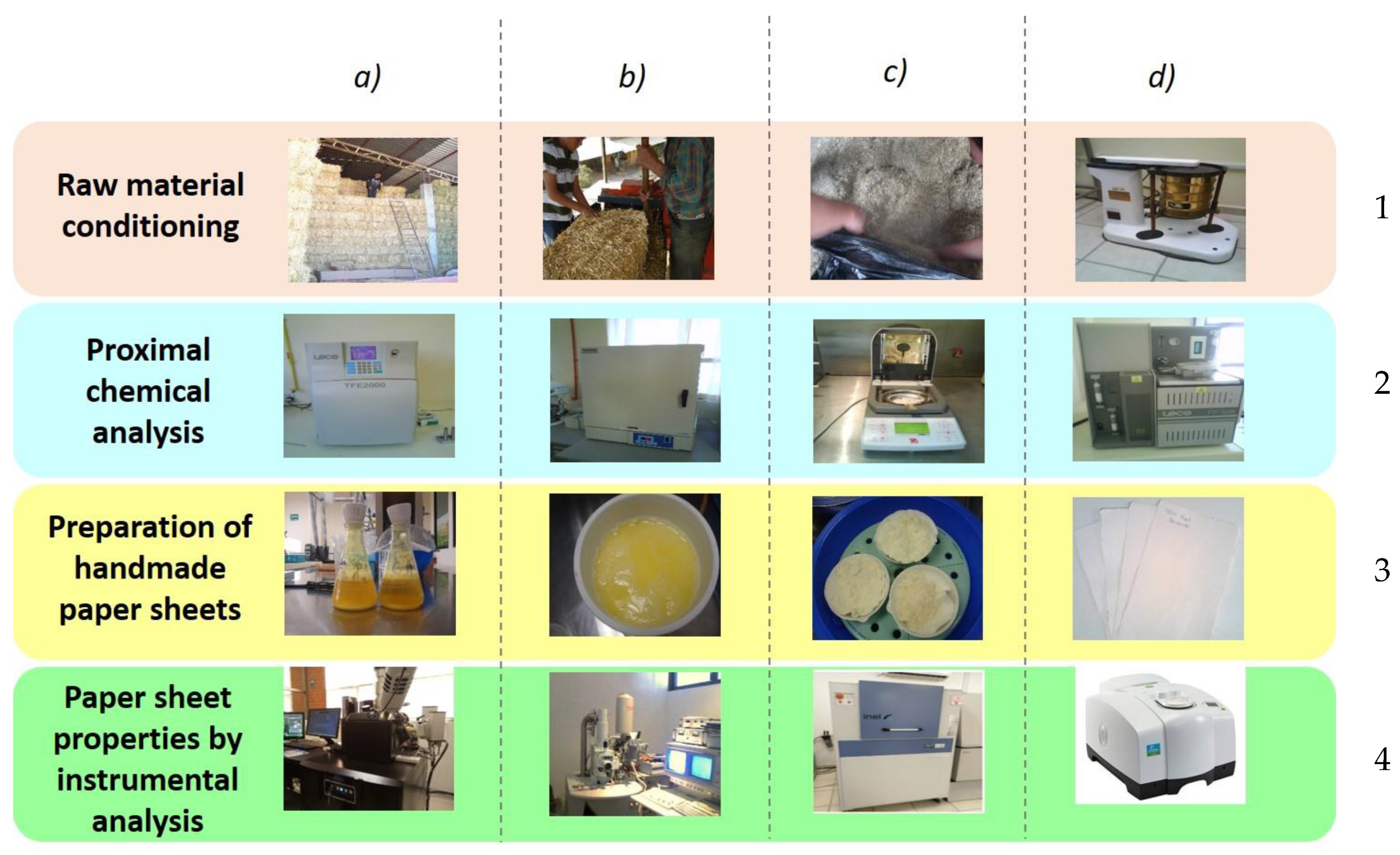
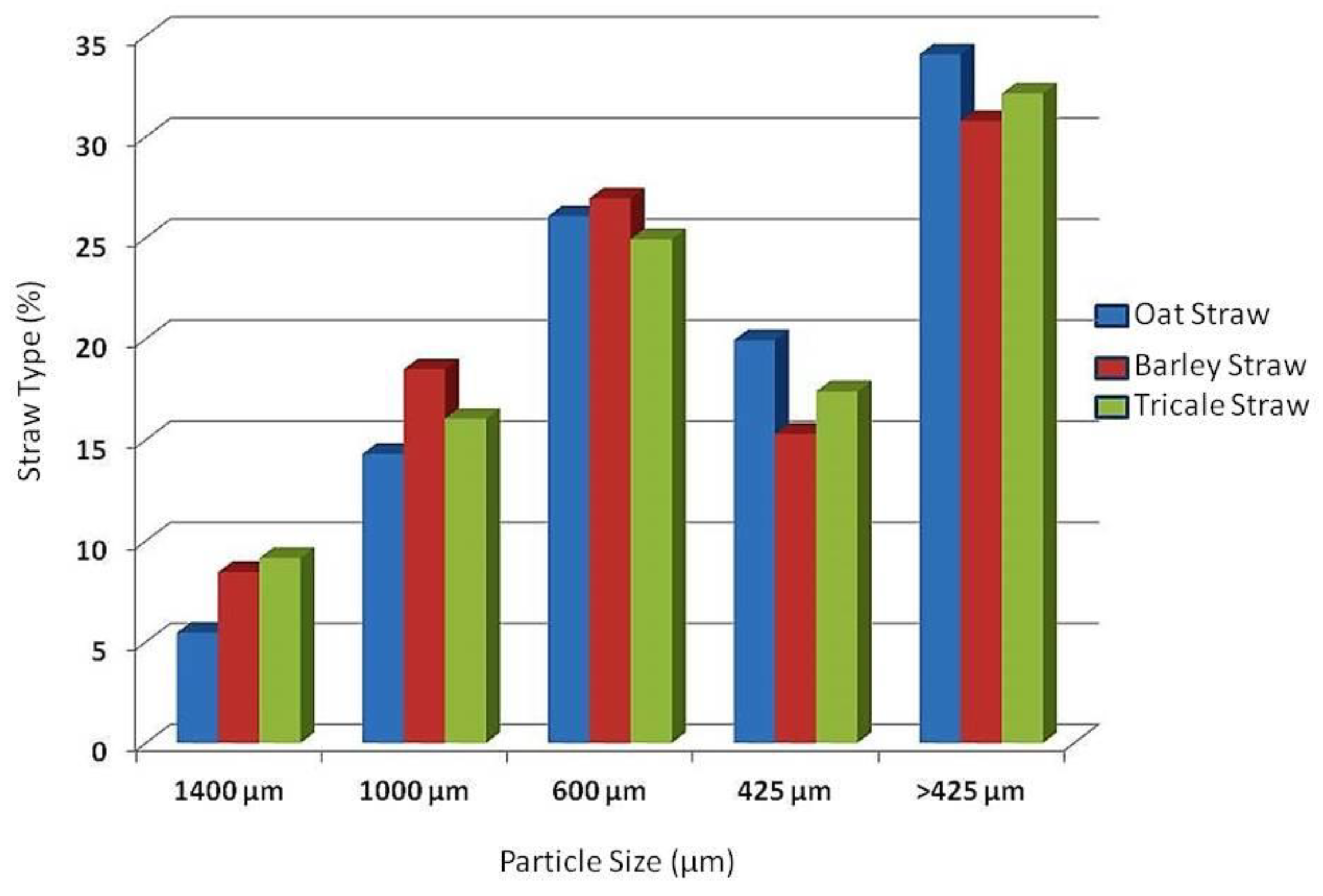

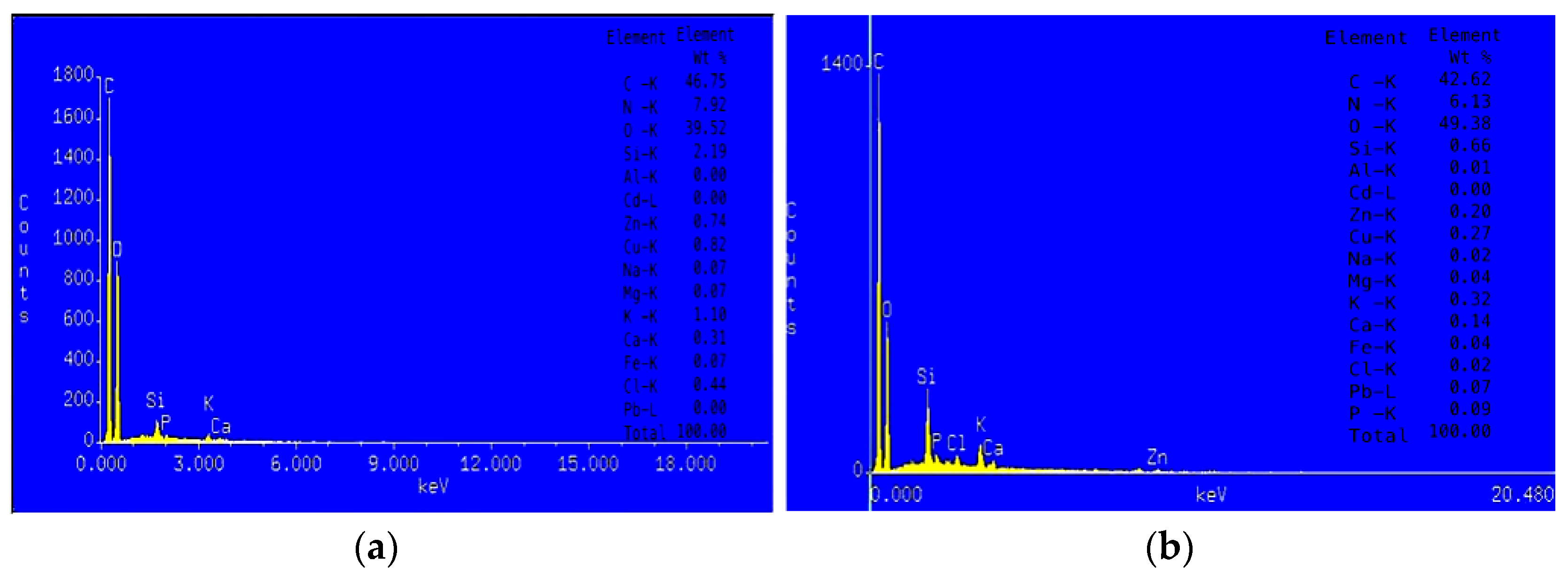
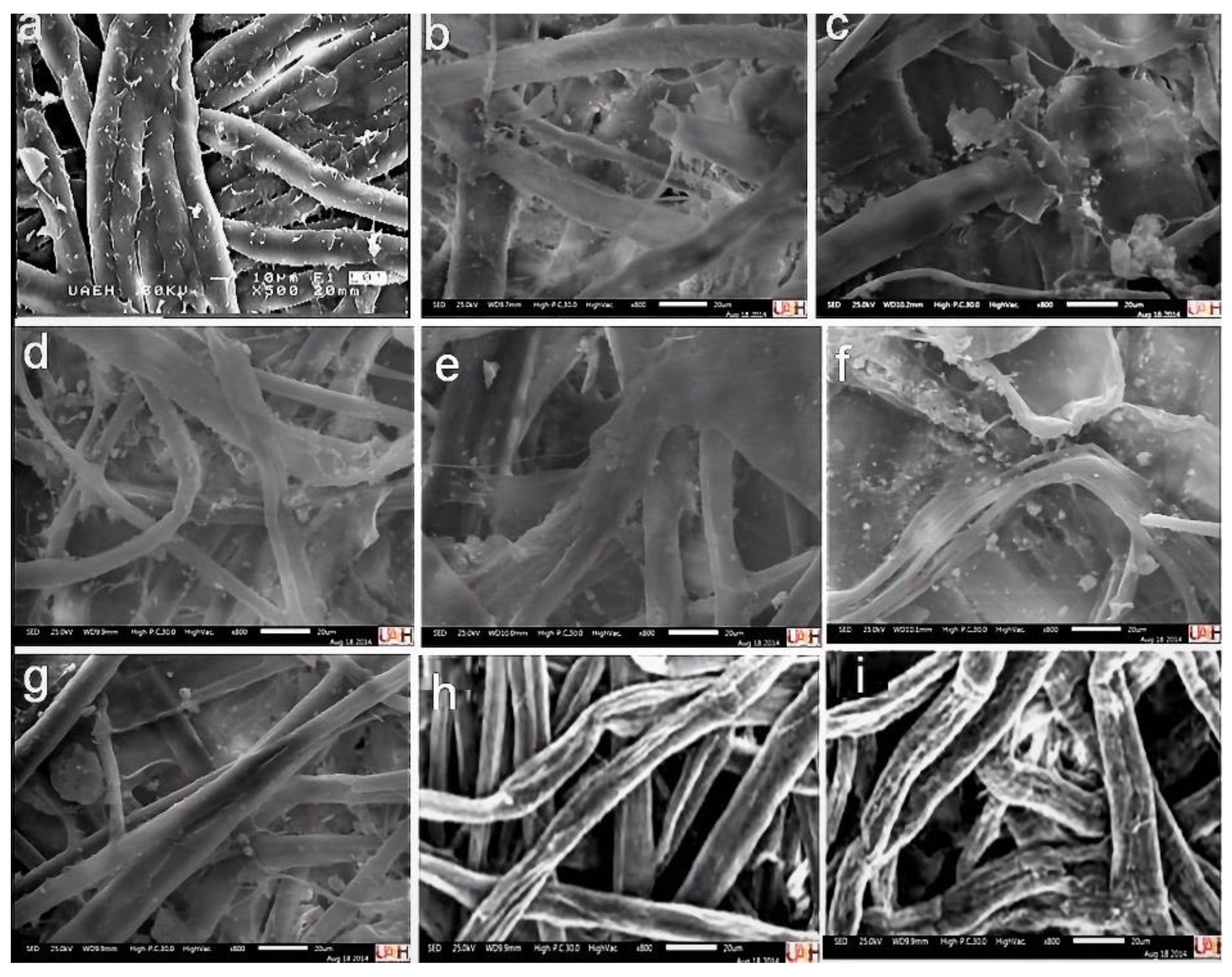
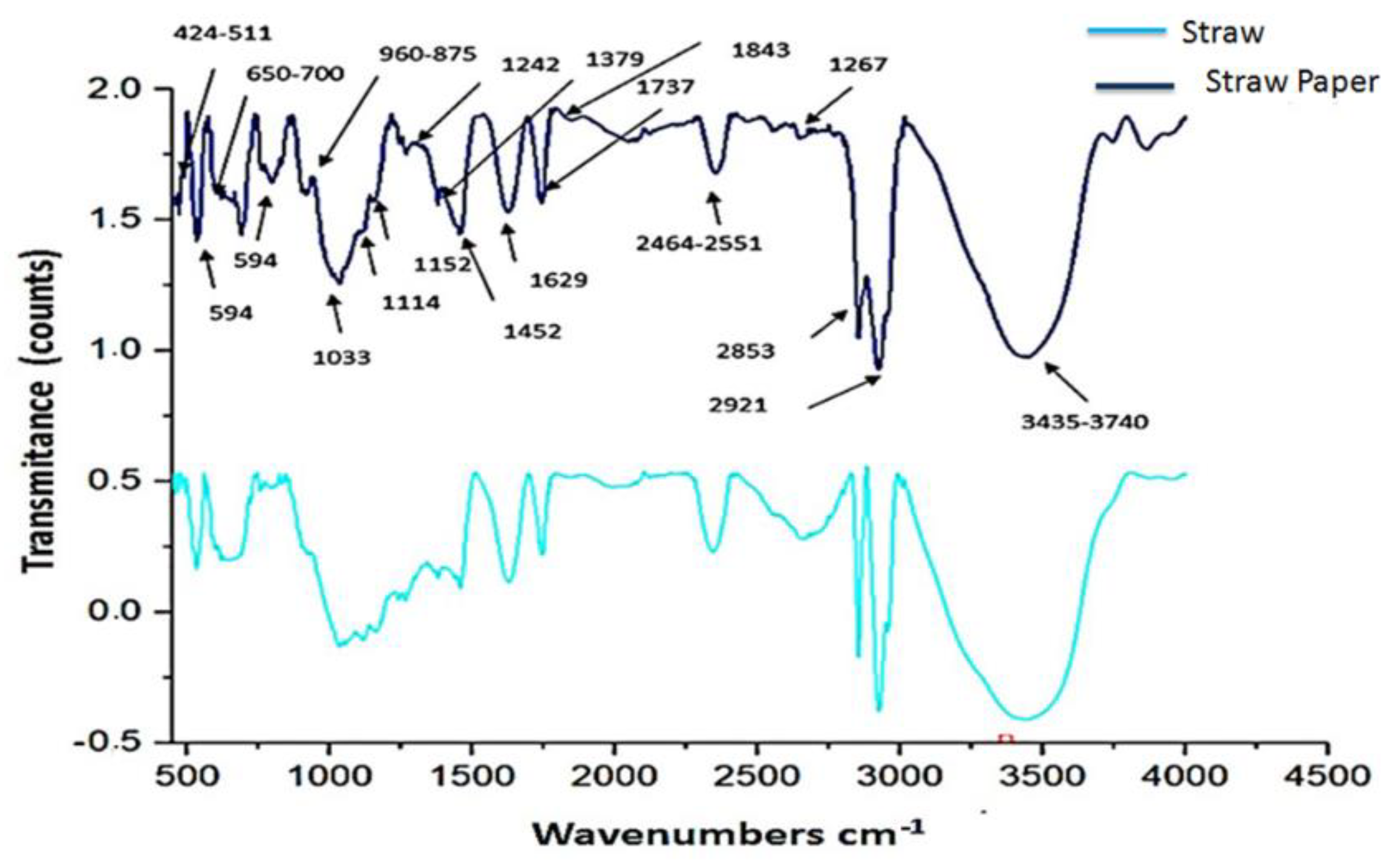
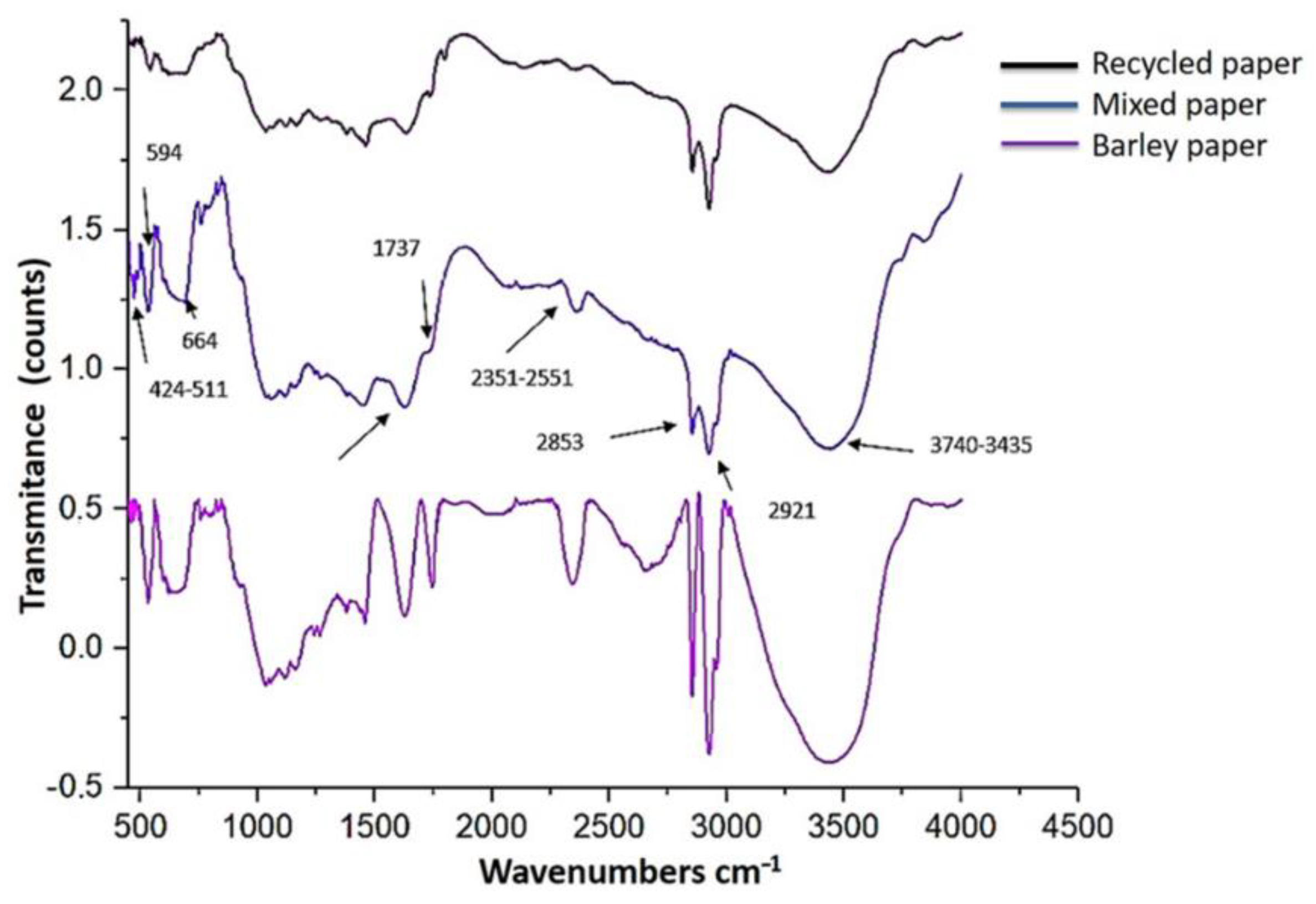

| Sheet Paper | Barley Straw | Recycled Paper |
|---|---|---|
| A | 0 | 100 |
| B | 20 | 80 |
| C | 40 | 60 |
| D | 50 | 50 |
| E | 60 | 40 |
| F | 80 | 20 |
| G | 100 | 0 |
| Straw | Moisture | Protein | Holocellulose | Lignin | Ash | References |
|---|---|---|---|---|---|---|
| Triticosecale | 9.1 (0.2) | 8.9 (0.2) | 73.4 (0.5) | 14.0 (0.3) | 4.8 (0.1) | This work |
| Hordeum Vulgare | 8.1 (0.2) | 10.3 (0.3) | 70 (0.3) | 12.8 (0.4) | 5.7 (0.1) | This work |
| Avena sativa | 11.9 (0.4) | 8.6 (0.4) | 71.5 (0.7) | 15.1 (0.4) | 4.7 (0.1) | This work |
| Hordeum Vulgare | 73.8 | 15.9 | 8.3 | [28] | ||
| Triticum | 5.35 | 1.3 | 14.9 | 8.3 | [25] | |
| Zea mays | 78.86 | 23 | 0.761 | [29] | ||
| Saccharum officinarum | 73.24 | 19.98 | 1.3 | [29] | ||
| Hordeum Vulgare | 5.6 | 56.3 | 18.2 | 10.34 | [26] | |
| Hordeum Vulgare ZMC | 7.49 | 2.22 | 15.2 | [27] | ||
| Hordeum Vulgare TCV | 7.89 | 4.93 | 12.5 | [27] | ||
| Hordeum Vulgare TLM | 9.10 | 7.72 | 12.2 | [27] | ||
| Hibiscus cannabinus | 73.2 | 12.5 | 0.6 | [30] | ||
| Ochroma pyramidale | 82 | 23 | 0.49 | [31] | ||
| Ceiba pentandra | 79 | 26.2 | 1.6 | [31] | ||
| Hevea brasiliensis | 80.1 | 19.8 | 0.7 | [31] |
| α-Cellulose | β-Cellulose | γ-Cellulose | References | |
|---|---|---|---|---|
| Avena sativa | 40.1 (0.3) | 9.6 | 21.9 (0.1) | This work |
| Triticosecale | 18.3 (3.0) | 11.4 | 43.8 (0.2) | This work |
| Hordeum Vulgare | 36.4 (1.9) | 7.7 | 26 (0.1) | This work |
| Triticum | 34.8 | 1.7 | 8.6 | [25] |
| Triticum | 36.6 | 16 | 10 | [32] |
| Brassica nigra L. | 15.1 | 9.4 | 3.02 | [33] |
| Camelina sativa L. | 20.9 | 14.2 | 4.1 | [33] |
| Agave americana | 19.2 | 4.6 | 0.24 | [34] |
| A. americana var. marginata | 19.2 | 4.6 | 0.26 | [34] |
| Alcea rosea | 37.96 | 3.6 | 10.4 | [34] |
| Hibiscus rosa-sinensis | 45.4 | 3.9 | 6.7 | [34] |
| Yucca guatemalensis | 31.9 | 4.9 | 1.1 | [34] |
| L. leucocephala | 42.9 | 17.7 | 14.6 | [35] |
| C. equisetifolia | 43.9 | 17.2 | 13.3 | [35] |
| Andropogon gayanus | 32.83 | 2.45 | 13.72 | [34] |
| Arundo donax | 44.82 | 2.7 | 6.48 | [34] |
| Cortaderia jubata | 11.36 | 0.8 | 3.84 | [34] |
| Guadua angustifolia | 36.8 | 7.36 | 1.84 | [34] |
| Lavatera arborea | 41 | 7.5 | 1.5 | [34] |
| Linum usitatissimum | 49.56 | 4.13 | 5.31 | [34] |
| Saccharum officinarum | 33.54 | 2.15 | 7.31 | [34] |
| Sida poeppigiana | 48.14 | 5.22 | 4.64 | [34] |
| Sida rhombifolia | 25.74 | 2.31 | 4.95 | [34] |
| Residuos de piña (hojas) | 93 | 5.8 | 1.25 | [36] |
| Beech | 91.9 | 7.6 | 2.3 | [37] |
| Spruce | 94.8 | 3.7 | 2.0 | [37] |
| Eucalyptus | 97.9 | 3.6 | 1.0 | [37] |
| Pine | 91.0 | 8.2 | 2.3 | [37] |
| Bleached fiber | 94.97 | 2.36 | 2.67 | [37] |
| Deinked fiber | 84.24 | 7.41 | 8.35 | [38] |
| Acacia farnesiana | 94.6 | 0.5 | 2.7 | [39] |
| Characteristics | Pulping Method Cellulose | Home Method Cellulose |
|---|---|---|
| FWHM (peak width) | 3.726 | 3.82 |
| 2-Theta (°) | 20.6 | 20.66 |
| Crystalline area | 629 | 637 |
| % of crystallinity | 74.78% | 64.24% |
| Crystal size | 22 Å | 22 Å |
Publisher’s Note: MDPI stays neutral with regard to jurisdictional claims in published maps and institutional affiliations. |
© 2022 by the authors. Licensee MDPI, Basel, Switzerland. This article is an open access article distributed under the terms and conditions of the Creative Commons Attribution (CC BY) license (https://creativecommons.org/licenses/by/4.0/).
Share and Cite
Román-Gutiérrez, A.D.; Duana-Ávila, D.; Hernández-Ávila, J.; Cerecedo-Saenz, E.; Salinas-Rodríguez, E.; Rojas-León, A.; López Perea, P. Reuse of Barley Straw for Handmade Paper Production. Sustainability 2022, 14, 12691. https://doi.org/10.3390/su141912691
Román-Gutiérrez AD, Duana-Ávila D, Hernández-Ávila J, Cerecedo-Saenz E, Salinas-Rodríguez E, Rojas-León A, López Perea P. Reuse of Barley Straw for Handmade Paper Production. Sustainability. 2022; 14(19):12691. https://doi.org/10.3390/su141912691
Chicago/Turabian StyleRomán-Gutiérrez, Alma Delia, Danae Duana-Ávila, Juan Hernández-Ávila, Eduardo Cerecedo-Saenz, Eleazar Salinas-Rodríguez, Adriana Rojas-León, and Patricia López Perea. 2022. "Reuse of Barley Straw for Handmade Paper Production" Sustainability 14, no. 19: 12691. https://doi.org/10.3390/su141912691
APA StyleRomán-Gutiérrez, A. D., Duana-Ávila, D., Hernández-Ávila, J., Cerecedo-Saenz, E., Salinas-Rodríguez, E., Rojas-León, A., & López Perea, P. (2022). Reuse of Barley Straw for Handmade Paper Production. Sustainability, 14(19), 12691. https://doi.org/10.3390/su141912691








